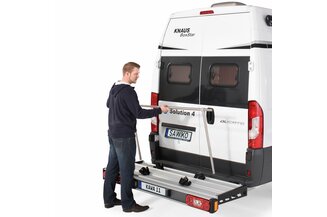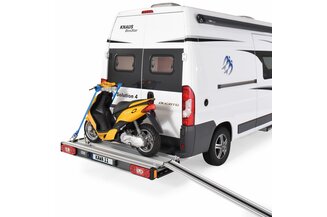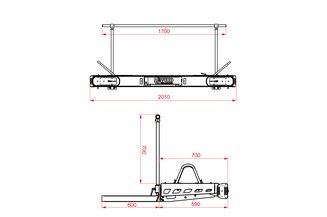Description
KAWA II - with variable platform design for the van
The all-aluminium KAWA II platform carrier for vans has a variable platform design and can be optimally adapted to your needs. No matter whether you want to transport a scooter, up to 3 bicycles or e-bicycles. With its 150 kg payload (optionally 200 kg) this is no problem. Put together the KAWA II that suits you best.
The platform is closed, which means that the load is no longer so exposed to splashing water. The retaining arms and tyre wedges with the convenient ratchet quick-release fastener are very suitable for e-bicycles, for example. They are the ideal complement to the KAWA II. The grab rail is removable to open the rear doors of your van completely. This gives you free access to the storage space in the rear. The wheel brackets included in the scooter set as well as the wheel trays for bicycles are infinitely adjustable to optimally fit your vehicle.
Integrated ramp
The ramp (KAWA II for 1 scooter) is integrated into the platform and can be transported safely in a space-saving manner. For loading, it is simply pulled out from under the platform.
Your advantage:
- Payload: up to 150 kg (optionally 200 kg)
- EG type approval available
- For 1 scooter or max. 3 bicycles
- With integrated ramp (scooter set-up kit)
- Variable platform design
- Free access to the rear doors
- Removable grab rail
- Ratchet quick-release tyre chocks and arms
- Completely made of aluminium
- Removable without tools
- Incl. Mounting elements for panel vans
Framework sets:
- KAWA II platform carrier (without front retaining bracket).
- KAWA II platform carrier for 1 scooter - incl. integrated drive-on ramp, wheel stirrups, tensioning belts, ring eyelets (without front retaining bracket)
- KAWA II platform carrier for 2 bicycles - incl. front grab rail, tire wedges, grab arms
- KAWA II platform carrier for 3 bikes - incl. front grab rail, tire wedges, grab arms
- KAWA II platform carrier setup set front grab rail for retrofit
- KAWA II platform carrier setup set for 3 bicycles
| Article number | Set-up set | Payload | Weight | Material | Height | Loading depth | Wide |
|---|---|---|---|---|---|---|---|
| 1884641 | Platform support without retaining bracket | 150 kg | 19.5 kg | 700 mm | 590 mm | 2010 mm | |
| 1884642 | 1 scooter | 150 kg | 51.3 kg | 700 mm | 590 mm | 2010 mm | |
| 1884643 | 2 bicycles | 150 kg | 48.8 kg | 700 mm | 590 mm | 2010 mm | |
| 1884644 | 3 bicycles | 150 kg | 49.2 kg | 700 mm | 590 mm | 2010 mm |





